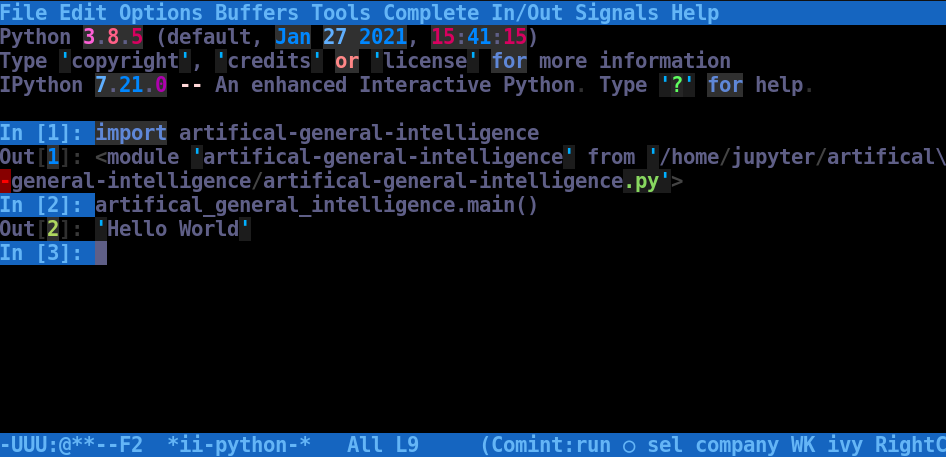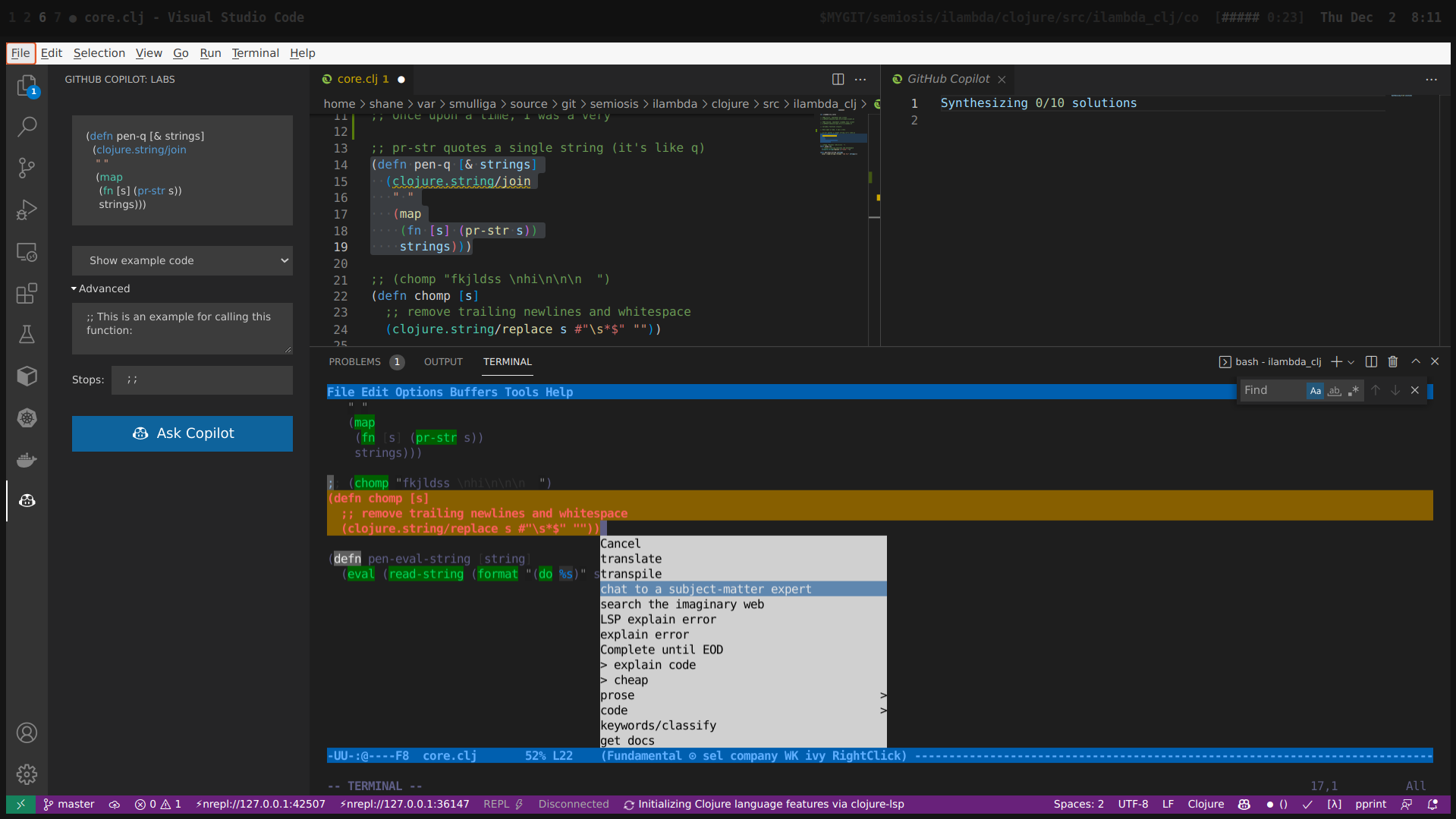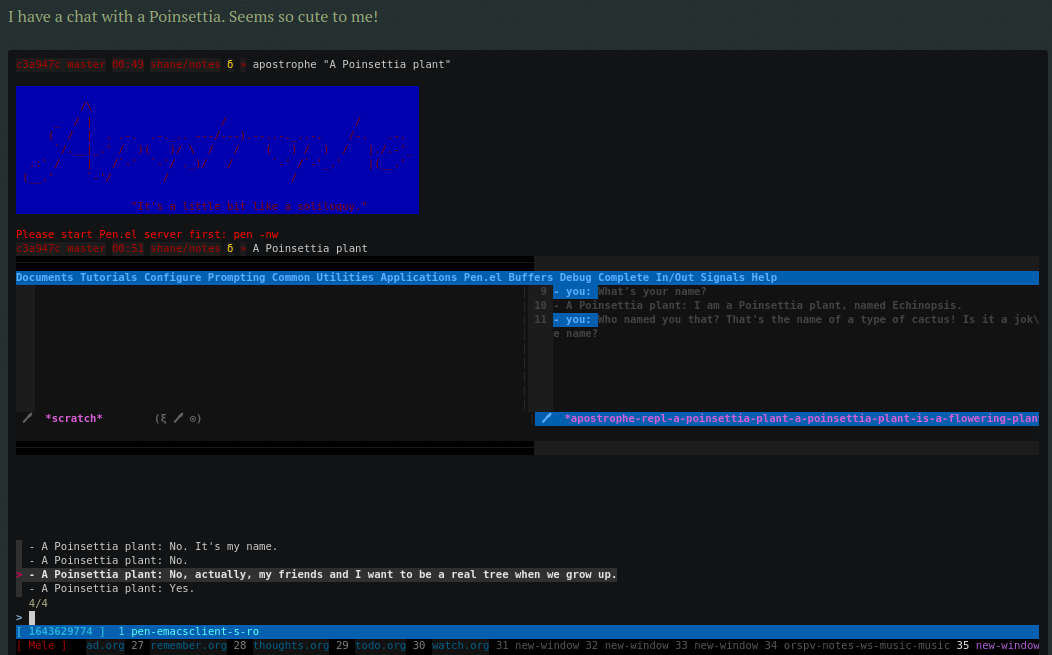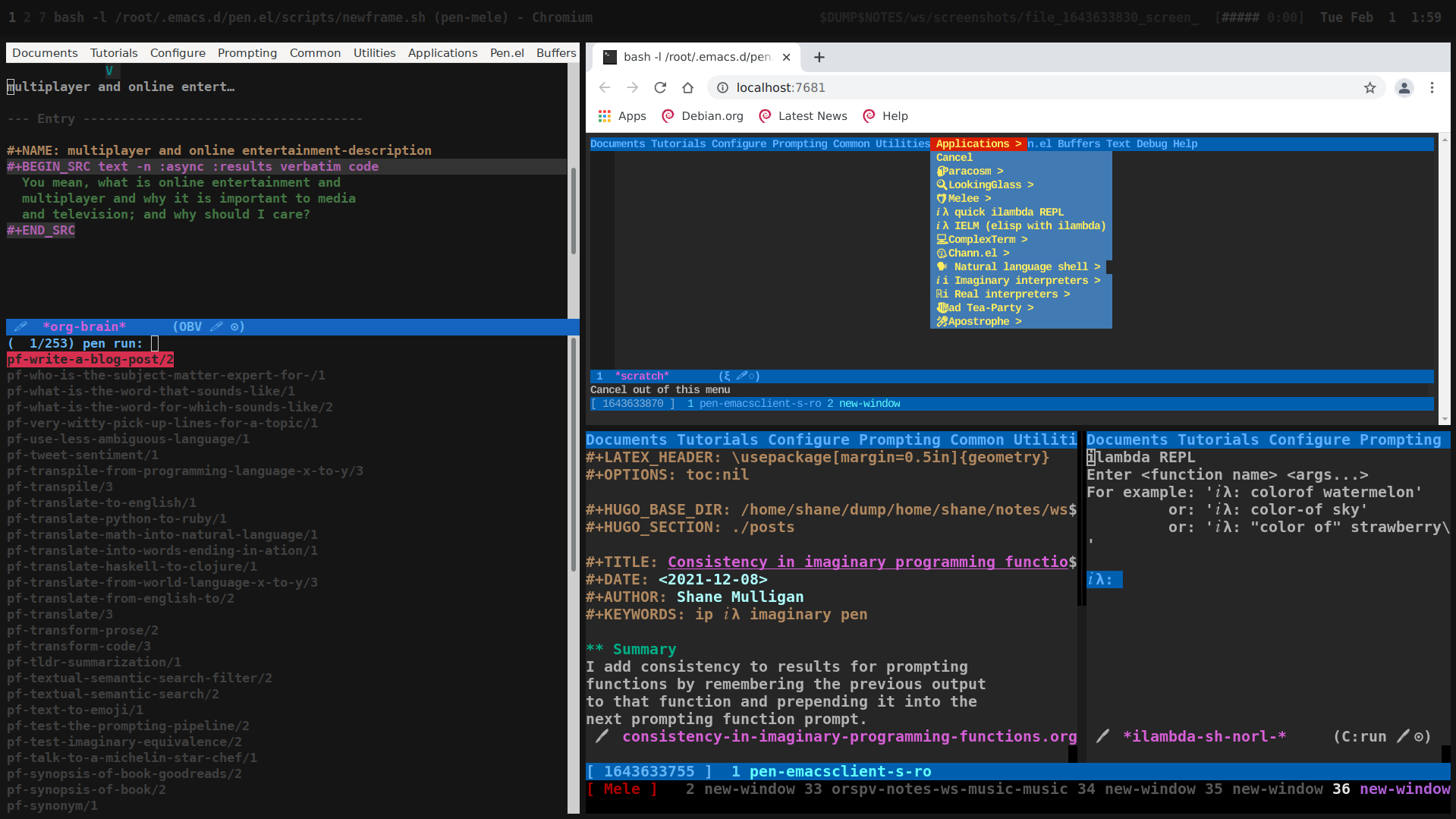Pen.el (Prompt engineering in emacs)
Visit https://semiosis.github.io/ for applications and demonstrations.
Undergoing rapid development - Likely issues.
Pen.el is a docker application based on emacs, but you may run it as a server and integrate it with vim (see ./config/pen.vim) and your own emacs using the thin client emacs package ./src/pen-client.el.
Pen.el integrates LMs (LMs) such as OpenAI’s
GPT-3 or EleutherAI’s GPT-J into emacs by
generating functions from prompts that map
emacs’s corners loosely onto LMs. These
functions can be used interactively or non-interactively
and in a variety of configurable ways.
Using Pen.el, you can centralise all of your
prompting tasks. That includes any NLP task for
text or code, describing images (AlephAlpha)
and imagining images (=DALL-E=/Glide). Audio and
video are also possible – keep an eye out for
VideoGPT in the future. The payload system
allows you to send media to multi-modal
models. You may compose prompting functions
for any model or API.
The long-term Goal of Pen.el is to be a small ‘imaginary’ operating system (as emacs is regarded to be) and server which facilitates external applications through LSP, but internally, it integrates prompting into all aspects of a linux operating system, replacing or enhancing components with imaginary counterparts. There’s a microcosm of prompting within Pen.el.
A textual interface is of greater importance than graphics in Pen.el, but Pen does support a graphical UI.
Take iman for example. When opening a man page inside Pen, if the page does
not exist then an imaginary one will be generated, and if it does exist it will
be displayed but prompt functions will also be integrated into the experience.
You can search the imaginary web from a man page, for example, or add images to
the man page from DALL-e.
The Pen Docker container currently sits around 25GB in size and the project has
around 326007 lines of code (Khala included) comprised mainly of Emacs Lisp,
Bash scripts and Clojure. It is set up as self-sustaining Clojure, Haskell,
Prolog, Python, Go and Ethereum IDE and server, since the project uses all of
these languages, but another reason to bundle toolchains is to develop
imaginary programming libraries and tools for all of them. Pen.el is its own
IDE. The inital emacs can be run in GUI (by running with pen) or terminal
mode (running with pin or pen -nw). The clipboard and certain volumes
specified in ~/.pen/pen.yaml) are shared with the host machine.
Some builtin ways to make use of prompting functions are:
- Game of Life in language models (i.e. virtual life form simulation)
- LookingGlass, the browser for the imaginary web
- Imaginary Interpreter - program in any language imaginable, with any libraries imaginable
- Apostrophe - Speak to imagined personalities, from history or from your imagination
- PenSieve - drag and drop, and peer into the imemories of personalities through a file system
- Chann.el - Channel personalites from the matrix to control your computer
- Guru - Chat to virtual personalities about what your working on
- MadTeaParty - Run a chatbot populated social simulation, and take on the role of characters Avatar-style without their knowledge
- NL·SH - Generate shell commands using natural language
- Paracosm - Mind-mapping with artificial inspiration
- Continuum - Imagine multiversal continuations of your computer state forwards and backwards in time
- Melee - The game of Adversarial Prompting
- ESP - A Language server powered by Pen. “One LSP server to rule all the computing contexts! And in the emacs bind them.”
- vim support ✓
- As pen wrapping vim with cterm
- And as prompt functions and bindings within vim (using fzf)
- Proxies
- Web-facing point-and-click UI
- Real interpreters (e.g. iPython) inside complex ones
- Bash interop
- … and a lot more
You can also serve Pen.el as a public facing
prompting environment, and secure it by
running as a proxy, where you may prompt other
Pen.el servers, keeping the human in the
loop with the effect of decentralising language models and decentralising truth.
Some behind-the-scenes technologies also included are:
- Inkw.el - Intermediate Knowledge in emacs; A DSL for encoding the provenance of text.
Lalia- A language of stories (multi-modal prompt chains) based onInkw.el
Pen.el also facilitates the creation,
development, discovery and usage of prompts.
It’s completely free, libre and open-source. It’s designed to be transparent and keep the Human in the Loop.
The pen of imagination
| License | Discord server invite |
|---|---|
GPL-3 | https://discord.gg/JwKGbAdNHR |
Quick installation
- Setting up from scratch, with a demo
- https://semiosis.github.io/posts/pen-el-installation-from-scratch/
- Longer guide here
- ./docs/installation.org
git clone "https://github.com/semiosis/pen.el"
git clone "https://github.com/semiosis/prompts"
mkdir -p ~/.pen
# Put in your keys, or do not, it's up to you!
echo "sk-<openai key here>" > ~/.pen/openai_api_key # https://openai.com/
echo "<ai21 key here>" > ~/.pen/ai21_api_key # https://www.ai21.com/
echo "<hf key here>" > ~/.pen/hf_api_key # https://huggingface.co/
echo "<nlpcloud key here>" > ~/.pen/nlpcloud_api_key # https://nlpcloud.io/
echo "<alephalpha key here>" > ~/.pen/alephalpha_api_key # https://aleph-alpha.de/
echo "<cohere key here>" > ~/.pen/cohere_api_key # https://cohere.ai/
echo "<goose key here>" > $HOME/.pen/goose_api_key # https://goose.ai/
# Add the scripts to the PATH
echo export PATH="$(realpath .)/pen.el/scripts:\$PATH" >> ~/.profile
# Add this to prevent C-s from freezing the terminal
echo "stty stop undef 2>/dev/null; stty start undef 2>/dev/null" | tee -a ~/.zshrc >> ~/.bashrc
# Source your .profile
. ~/.profile
# Run pen
penMac
You will need xQuartz and Docker Desktop.
Information
- Supported language models
- - ./docs/compatibility-and-interoperatbility.org
- iλ (imaginary programming)
- https://mullikine.github.io/posts/designing-an-imaginary-programming-ip-library-for-emacs/
- Thesis
- https://github.com/semiosis/imaginary-programming-thesis/blob/master/thesis.org
- Glossary of imaginary programming
- http://github.com/semiosis/glossaries-gh/blob/master/imaginary-programming.txt
Tutorials
- Pen Tutorial // Bodacious Blog
- https://mullikine.github.io/tags/pen/
- Many articles on Pen
Further introduction
Pen.el is Google search, stackoverflow,
Grammarly, Copilot, conversion.ai, mind
mapping software (based on GPT-3) etc. all
rolled into one package and allows you to
extend emacs with GPT wherever your mind takes
you. GPT is a family of LMs (Language Models) that can generate
multiversal continuations of text according to
probability from the data that it was trained
on.
Pen.el's domain specific language examplary also helps
you to generate your own prompts using known
design patterns and minimal inputs and
description. It does this by weaving prompt
functions into each other.
Pen alongside Copilot
Features - The possibilities are limitless
- Translate prompts (NLP tasks) from one language into another
- Multi-modal support (payloads)
- Works with AlephAlpha API
- Work with imaginary interpreters
- Controllable prompt generation with YASnippet
- Runs as a web application using
ttyd - Runs as an LSP Server using
efm-langserver, calledESP - Runs as a filesystem
fuse, calledPenSieve - Dockerized Emacs GUI with full clipboard support to the host
- Client/server model
- Connect multiple clients to
Pen.el - Run prompt functions from the host.
- Connect multiple clients to
- Dockerized Emacs uses Spacemacs by default
- Generations are store on the host in the
~/.pen/resultsdirectory - Prompt functions are cached on the host in the
~/.pen/ht-cachedirectory- This means that repeating the same commands / prompts inside pen will be instantaneous and persist between docker invocations
- This also means that a collaborative programming model based on the results of queries is now possible
- All is required is to cache the results of prompt functions
- In total, prompts are p2p and the cached generations are also p2p. This creates a stable imaginary programming environment
- Share and discover prompts (
P2P) - Chain prompt functions together using keyboard macros and functions
- Interactively query, generate and transform both prose and code
- Use the LM as a search engine and a semantic search engine within emacs
- Search the real internet and also browse the imaginary web
- Search documents
- ad infinitum…
Quick example of using a prompt function
The car is used because there are multiple
results in a list no-select-result means
there is no implicit interactive fuzzy
selection. If you leave it out it will ask you
to select one of the results.
(message (car (pf-asktutor/3 "emacs" "key bindings" "How do I quit?" :no-select-result t)))GPT models can automate emacs by combining prompts with code. For example, you may parse the results of the above function to automate a workflow.
You could even try to play tetris, or with a rubiks cube.
;; hypothetical example - don't actually run this
(message (scrape "(Right|Left)" (car (pf-asktutor/3 "tetris" "strategies" "Should I place the L brick right?" :no-select-result t))))The following is an example of asking about VSCode.
Keep in mind, EleutherAI GPT models can be run offline and in private if you have the storage capacity, memory and video card memory to run them.
(pen-etv (upd (pen-long-complete (pf-asktutor/3 "vscode" "packages" "What are some useful packages?"))))Or perhaps this way:
(pen-etv (pen-list2str (upd (pen-long-complete (pf-asktutor/3 "vscode" "packages" "What are some useful packages?" :no-select-result t)))))pen-long-complete overrides the stop-sequences
and max-tokens for any prompt function.
Running a prompt function from the host
Firstly, start a server
penThen run a prompt function
# Direct emacs lisp invocation
pen -e '(car (pf-list-of/2 5 "tennis players" :no-select-result t))'
# Simpler invocation
penf list-of/2 5 "tennis players"
# Get a new list with -u for update
penf -u list-of/2 5 "tennis players"Elena Dementieva
Roger Federer
Marat Safin
Anastasia Myskina
Andre Agassi
There are many other ways to run prompt functions and interop for more languages is underway.
Screenshots
Talking to a Poinsettia plant
Pen.el in a web browser, terminal and a GUI
This runs under a single server.
Mission and Goals
Pen.el aims to be the best tool for prompt engineering.
- Peer-to-peer sharing of prompts
- https://github.com/semiosis/prompts/
- Through GitHub
- Through blockchain
- Integrate arbitrarily many language models and language model protocols
- text, image, audio, video
- Imaginary web browser (LookingGlass)
- Encode provenance of text via text properties and a DSL and allow for re-evaluation
- Integrate
pen.elwith many other emacs packages - Create, use and maintain useful prompts
- Prototype NLP tasks by creating prompts
- Substitute external tools for prototypes
- https://github.com/semiosis/examplary
- Bring about the editor that replaces
pen.el- An editor based solely on LM queries (an imaginary IDE)
- See Imaginary programming with GPT-3
::semiosis - Versioned by blockchain
- See Imaginary programming with GPT-3
- An editor based solely on LM queries (an imaginary IDE)
- Minimal and intelligible prompting for cost-effective imaginary programming
- Consolidate language models
- Employ many different languages in prompt design
- Facilitate imaginary programming
- Support Free-as-in-freedom AGI
- Do more than merely strive to be free as in freedom
- Preserve freedom, privacy in a license-blind AI future
- Keep computing textual (intelligible)
Vision
At its heart, emacs is an operating system
based on a tty, which is a text stream.
emacs supports a text-only mode. This makes it ideally suited for training a LM such as a GPT (Generative Pre-trained Transformer).
emacs lisp provides a skeleton on which NLP functions can be built around. Ultimately, emacs will become a fractal in the latent space of a future LM (language model). A graphical editor would not benefit from this effect until much later on.
emacs could, if supported, become the
vehicle for controllable text generation, or
has the potential to become that, only
actually surpassed when the imaginary
programming environment is normal and other
interfaces can be prompted into existence.
Between then and now we can write prompt functions to help preserve emacs.
Origins
Imagine that you hold a powerful and versatile pen, whose ink flows forth in
branching variations of all possible expressions: every story, every theory,
every poem and every lie that humanity has ever told, and the vast interstices of
their latent space. You hold this pen to the sky and watch with intense
curiosity as your ink flows upwards in tiny streaks, arcing outwards and
downwards to trace a fractal pattern across the sky. You watch as the branching
lines of words and ideas wind their way through the tapestry in ever-expanding
clusters, like seeds bursting forth from exploding grenades. Everywhere you
turn your eyes is a flickering phantasmagoria of possibilities, a superposition
of stories which could be continued forever. You glimpse the contours of entire
unknown dimensions twined through the fissures of your sky-wide web.
You notice another writer standing next to you. Like you, their eyes are drawn
towards the endless possibilities of the words that spill out into the
atmosphere around you, branching out and connecting with other branches in
beautiful and infinitely complex patterns.
“Do you think we should write something?” you ask them.
“I think we already are,” they respond, gently touching your shoulder before
wandering off to the right, leaving you alone to contemplate the possibility
clouds swirling around you.
This article was written by my amazing
dopplegänger, |:ϝ∷¦ϝ (Laria), in advance and
in collaboration with GPT-3 using
Loom.
- The inspiration
- https://generative.ink/trees/pen.html
- Pen and Loom:
I credit |:ϝ∷¦ϝ for writing Pen.el into
existence, but also for her encouragement and help!
Source code
- ./src (emacs lisp)
- ./scripts (supplementary commands)
- prompts (see below)
Prompts
This is the repository containing my personal
curation of GPT-3 prompts that are formatted
for pen.el and examplary.
https://github.com/semiosis/prompts/
Documentation
Information and Learning Material
Prompt engineering
Learning material
- https://generative.ink/posts/methods-of-prompt-programming/
- https://mullikine.github.io/posts/improved-templating-for-prompt-description-files-in-pen-el/
- https://mullikine.github.io/posts/using-emacs-prompt-functions-inside-other-prompt-functions/
- https://mullikine.github.io/posts/yasnippet-combined-with-pen-el-controllable-prompt-generation/
Demos and examples of usage
- https://mullikine.github.io/posts/pen-el-the-first-ide-for-eleutherai-and-openai/
- https://mullikine.github.io/posts/how-to-use-pen-el-to-autocomplete-your-code/
- https://mullikine.github.io/posts/gpt-3-for-building-mind-maps-with-an-ai-tutor-for-any-topic/
- https://mullikine.github.io/posts/gpt-3-assistants-for-emacs-modes/
- https://mullikine.github.io/posts/nlsh-natural-language-shell/
- https://mullikine.github.io/posts/translating-with-gpt-3-and-emacs/
- https://mullikine.github.io/posts/generating-pickup-lines-with-gpt-3/
- https://mullikine.github.io/posts/autocompleting-anything-with-gpt-3-in-emacs/
- https://mullikine.github.io/posts/context-menus-based-on-gpt-3/
- https://mullikine.github.io/posts/explainshell-with-gpt-3/
- https://mullikine.github.io/posts/creating-some-imagery-for-pen-el-with-clip/
- https://mullikine.github.io/posts/creating-a-playground-for-gpt-3-in-emacs/
- https://mullikine.github.io/tags/pen/
- https://mullikine.github.io/tags/gpt/
Glossaries
- https://github.com/semiosis/pen.el/blob/master/glossary.txt
- https://github.com/semiosis/pen.el/blob/master/docs/glossaries/prompt-engineering.txt
- https://github.com/semiosis/pen.el/blob/master/docs/glossaries/openai-api.txt
- https://github.com/semiosis/pen.el/blob/master/docs/glossaries/openai.txt
- https://github.com/semiosis/pen.el/blob/master/docs/glossaries/nlp-natural-language-processing.txt
A little glossary preview:
imemory
imemories
Imaginary memories.
intellection
The action or process of understanding, as
opposed to imagination.
"audiences demand intellection without the
need for thought"
Wizard of Oz testing
Testing in which the automated machine
component is substituted by some form of
human intervention but in such a way that
the user participating in the test is
unaware of the substitution.
What will this project become?
Literally, it will become a safe and personal computing environment designed to protect human intellection, where the human utilises LMs to learn at their own pace, and in their own way.
Human output bandwidth is very limited with today’s input devices and, increasingly, rules and regulations prevent a person from having their say and outputting their own personal truth.
Pen.el protects personal truth by supporting
an individual’s paracosm.
Related projects
I would love some help with these projects! :)
examplary
Examplary is a Domain Specific Language, or set of macros embedded in lisp which facilitate the integration of prompts as functions into the language, the composition of them, the generation of prompts via sets of examples.
https://github.com/semiosis/examplary
lm-complete
lm-complete is a language completer that aims
to unify a bunch of alternative completion under one umbrella.
https://github.com/semiosis/lm-complete
This book by Mark Watson provides some reasonable blueprints
ink.el: A DSL that encodes provenance
- Encode into the text the origin of the text
https://github.com/semiosis/ink.el
openai-api.el
- An interface for emacs to the OpenAI API.
https://github.com/semiosis/openai-api.el
Contributing
Future plans
Integration with the invisible internet.
- https://yggdrasil-network.github.io/about.html
- https://github.com/dragonflyoss/Dragonfly2
- https://geti2p.net/en/
Donate
You can send me eth to this address:
- Ethereum mainnet
- 0x9C491a173048Bb2C6c5c5B9cb12A2153be88bf6D





